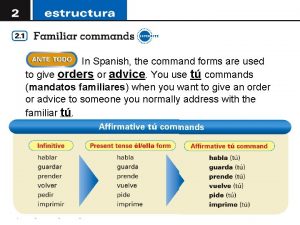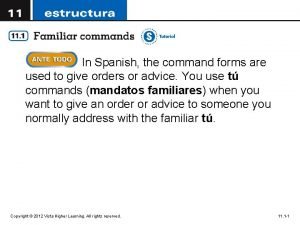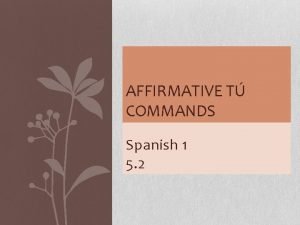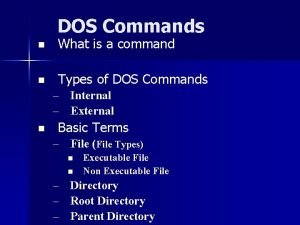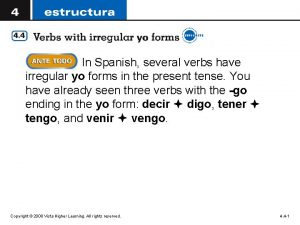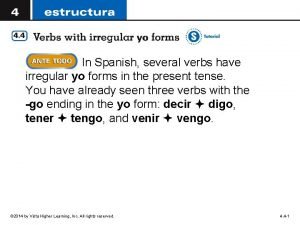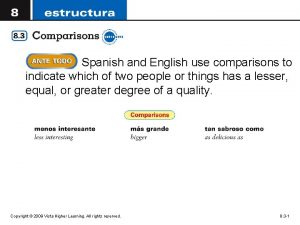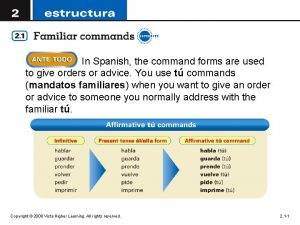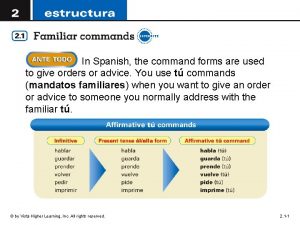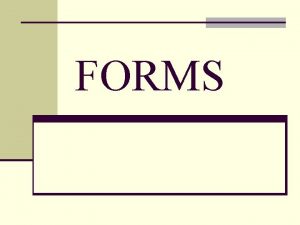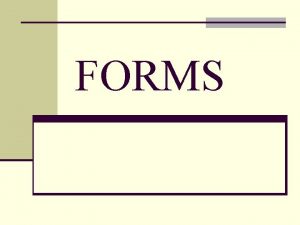In Spanish the command forms are used to













- Slides: 13

In Spanish, the command forms are used to give orders or advice. You use tú commands (mandatos familiares) when you want to give an order or advice to someone you normally address with the familiar tú. u © by Vista Higher Learning, Inc. All rights reserved. 2. 1 -1

u. Affirmative tú commands usually have the same form as the él/ella form of the present indicative. © by Vista Higher Learning, Inc. All rights reserved. 2. 1 -2

u The following verbs have irregular affirmative tú commands. u Silly SENTENCE with a German accent: u Ven Di Sal Haz Ten Ve Pon Se © by Vista Higher Learning, Inc. All rights reserved. 2. 1 -3

u Since ir and ver have the same tú command (ve), context will determine the meaning. © by Vista Higher Learning, Inc. All rights reserved. 2. 1 -4

u The negative tú commands are formed by dropping the final -o of the yo form of the present tense, then adding the opposite vowel endings: For -ar verbs, add -es. For -er and -ir verbs, add -as. © by Vista Higher Learning, Inc. All rights reserved. 2. 1 -5

u Verbs with irregular yo forms maintain the same irregularity in their negative tú commands. u These verbs include conducir u conduzco, conocer, u conozco, decir, u digo, hacer, u hago, ofrecer, u ofrezco, oír, u oigo, poner © by Vista Higher Learning, Inc. All rights reserved. 2. 1 -6

u Pongo, u Salgo, salir, tener, u Tengo, traducir, u Traduzco traer, u Traigo, venir, u Vengo, ver u veo. © by Vista Higher Learning, Inc. All rights reserved. 2. 1 -7

u Note also that stem-changing verbs keep their stem changes in negative tú commands. © by Vista Higher Learning, Inc. All rights reserved. 2. 1 -8

u Verbs ending in -car, -gar, and -zar have a spelling change in the negative tú commands. © by Vista Higher Learning, Inc. All rights reserved. 2. 1 -9

u The following verbs have irregular negative tú commands. © by Vista Higher Learning, Inc. All rights reserved. 2. 1 -10

u ¡Atención! In affirmative commands, reflexive, indirect, and direct object pronouns are always attached to the end of the verb. u In negative commands, these pronouns always precede the verb. u Borrar Bórralos. / No los borres. Escribir Escríbeles un correo electrónico. / No les escribas un correo electrónico. © by Vista Higher Learning, Inc. All rights reserved. 2. 1 -11

u ¡Atención! (cont. ) When a pronoun is attached to an affirmative command that has two or more syllables, an accent mark is added to maintain the original stress: borra → imprime → bórralos imprímelo prende → préndela © by Vista Higher Learning, Inc. All rights reserved. 2. 1 -12

Indica los mandatos familiares afirmativos y negativos de estos verbos. 1. correr Corre más rápido. _____ corras más rápido. No _____ 2. llenar _____ el tanque. No _____ el tanque. 3. salir _____ ahora. No _____ ahora. 4. descargar _____ ese documento. No 5. levantarse _____ temprano. No 6. hacerlo No _____ ahora. _____ ya. © by Vista Higher Learning, Inc. All rights reserved. 2. 1 -13
 Antigentest åre
Antigentest åre Car gar zar
Car gar zar Indica los mandatos afirmativos y negativos de estos verbos
Indica los mandatos afirmativos y negativos de estos verbos Spanish informal
Spanish informal Sleep command in spanish
Sleep command in spanish Irregular affirmative tu commands
Irregular affirmative tu commands Subjunctive french
Subjunctive french Which command is used to set terminal io characteristic?
Which command is used to set terminal io characteristic? Pencil tool paint
Pencil tool paint Ver
Ver Final exam review packet spanish 1 and spanish 2 answer key
Final exam review packet spanish 1 and spanish 2 answer key Verbs with irregular yo forms
Verbs with irregular yo forms Verbs with irregular yo forms
Verbs with irregular yo forms Tú eres 1 of 1 (less) simpático que federico.
Tú eres 1 of 1 (less) simpático que federico.

